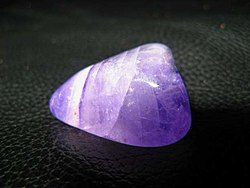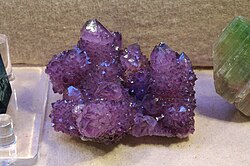Amethyst is a purple variety of quartz often used as an ornament. The name comes from the Greek a ("not") and methustos ("to intoxicate"), a reference to the belief that the stone protected its owner from drunkenness; the ancient Greeks and Romans wore amethyst and made drinking vessels of it in the belief that it would prevent intoxication.
| Quartz | |
|---|---|
 | |
| General | |
| Category | Mineral variety |
| Chemical formula | Silica (silicon dioxide, SiO2) |
| Identification | |
| Color | purple |
| Crystal habit | 6-sided prism ending in 6-sided pyramid (typical) |
| Crystal system | rhombohedral class 32 |
| Twinning | Dauphine law, Brazil law and Japan law |
| Cleavage | None |
| Fracture | Conchoidal |
| Mohs Scale hardness | 7 - lower in impure varieties |
| Luster | Vitreous/glossy |
| Refractive index | nω = 1.543 - 1.553 nε = 1.552 - 1.554 |
| Optical Properties | Uniaxial (+) (Positive) |
| Birefringence | +0.009 (B-G interval) |
| Pleochroism | None |
| Streak | White |
| Specific gravity | 2.65 constant; variable in impure varieties |
| Melting point | 1650 (±75) °C |
| Solubility | H2O insoluble |
| Diaphaneity | Transparent to translucent |
| Other Characteristics | Piezoelectric |
Amethyst is the purple variety of quartz, its chemical formula is SiO2.
In the 20th century, the color of amethyst was attributed to the presence of manganese. However, since it is capable of being greatly altered and even discharged by heat, the color was believed by some authorities to be from an organic source. Ferric thiocyanate was suggested, and sulfur was said to have been detected in the mineral.
More recent work has shown that amethyst's coloration is due to ferric iron impurities.[1] Further study has shown a complex interplay of iron and aluminium is responsible for the color.[2]
On exposure to heat, amethyst generally becomes yellow, and much of the citrine, cairngorm, or yellow quartz of jewelry is said to be merely "burnt amethyst." Veins of amethystine quartz are apt to lose their color on the exposed outcrop[citation needed].
Synthetic amethyst is made to imitate the best quality amethyst. Its chemical and physical properties are so similar to that of natural amethyst that it cannot be differentiated with absolute certainty without advanced gemological testing (which is often cost prohibitive). There is one test (which is not 100 percent certain) based on "Brazil law twinning" (a form of quartz twinning where right and left hand quartz structures are combined in a single crystal[3] which can be used to identify synthetic amethyst rather easily. In theory however it is possible to create this material synthetically as well, but this type is not available in large quantities in the market.[4]
Composition
Amethyst is composed of an irregular superposition of alternate lamellae of right-handed and left-handed quartz. It has been shown that this structure may be due to mechanical stresses. As a consequence of this composite formation, amethyst is apt to break with a rippled fracture or to show "thumb markings," and the intersection of two sets of curved ripples may produce on the fractured surface a pattern something like that of "engine turning." Some mineralogists, following Sir David Brewster, apply the name of amethyst to all quartz which exhibits this structure, regardless of color.
Because it has a hardness of 7 on the Mohs scale, amethyst is treasured for its use in jewelry.
Hue and Tone
Amethyst occurs in a continuum of primary hues from a light slightly pinkish violet to a deep grape purple. Amethyst may exhibit one or both secondary hues, red and/or blue. The ideal grade is called "Deep Siberian" and has a primary purple hue of around 75 - 80 percent, 15-20 percent blue and (depending on the light source) red secondary hues.[4]
History
Amethyst was used as a gemstone by the ancient Egyptians and was largely employed in antiquity for intaglios. Beads of amethyst are found in Anglo-Saxon graves in England. It is a widely distributed mineral, but fine, clear specimens that are suitable for cutting as ornamental stones are confined to comparatively few localities. Such crystals occur either in the cavities of mineral-veins and in granitic rocks, or as a lining in agate geodes. A huge geode, or "amethyst-grotto," from near Santa Cruz in southern Brazil was exhibited at the Düsseldorf, Germany Exhibition of 1902. Many of the hollow agates of Brazil and Uruguay contain a crop of amethyst crystals in the interior. Much fine amethyst comes from Russia, especially from near Mursinka in the Ekaterinburg district, where it occurs in drusy cavities in granitic rocks. Many localities in India yield amethyst.
Geographic distribution
Amethyst occurs at many localities in the United States, but these specimens are rarely fine enough for use in jewelry. Among these may be mentioned Amethyst Mountain, Texas; Yellowstone National Park; Delaware County, Pennsylvania; Haywood County, North Carolina; Deer Hill and Stow, Maine. It is found also in the Lake Superior region. Amethyst is relatively common in northwestern Ontario, and in various locations throughout Nova Scotia, but uncommon elsewhere in Canada. Amethyst is produced in abundance from the state of Minas Gerais in Brazil where it occurs in large geodes within volcanic rocks. It is also found and mined in South Korea. The largest opencast amethyst vein in the world is in Maissau, Lower Austria.
Value
Traditionally included in the cardinal, or most valuable, gemstones (along with diamond, sapphire, ruby, and emerald), amethyst has lost much of its value due to the discovery of extensive deposits in locations such as Brazil. The highest grade Amethyst (called "Deep Russian") is exceptionally rare and therefore its value is dependent on the demand of collectors when one is found. It is however still orders of magnitude lower than the highest grade sapphires or rubies (Padparadscha Sapphire or "Pigeon Blood" Ruby) which can go for as much as $50,000 or more per carat.[4]
Amethyst such as the "Russian" quality (bluish purple key color) and such as material recently found in Georgia since 2005 (with some of the stones showing both blue hue and red flashes) and of which its top material is considered of the best quality presently available [5] still command prices of not more than $50 per carat.[6]
Amethyst in folklore and astrology
Amethyst is the birthstone associated with February. It is also associated with the astrological signs of Pisces, Aries (especially the violet and purple variety), Aquarius, and Sagittarius. It is a symbol of heavenly understanding, and of the pioneer in thought and action on the philosophical, religious, spiritual, and material planes. Ranking members of the Roman Catholic Church traditionally wear rings set with a large amethyst as part of their office.
The Greek word "amethystos" (αμέθυστος) basically can be translated as "not drunken." Amethyst was considered to be a strong antidote against drunkenness, which is why wine goblets were often carved from it. Supposedly, when a drunken Dionysus was pursuing a maiden called Amethystos, who refused his affections, she prayed to the gods to remain chaste. The goddess Artemis granted the prayer, transforming her into a white stone; humbled by Amethystos' desire to remain chaste, Dionysus poured wine over the stone she had become as an offering, dyeing the crystals purple.
Variants of the story include that Dionysus, the god of intoxication, had been insulted by a mortal and swore revenge on the next mortal who crossed his path, creating fierce tigers to carry out his wish; the mortal turned out to be a beautiful young woman, Amethystos, who was on her way to pay tribute to Artemis. Her life is spared by Artemis, who transforms the maiden into a statue of pure crystalline quartz to protect her from the brutal claws. Dionysus wept tears of wine in remorse for his action at the sight of the beautiful statue. The god's tears stained the quartz purple.[7] Another variation involves the goddess Rhea presenting Dionysus with the amethyst stone to preserve the winedrinker's sanity.[8]
Notes
- ^ Klein, Cornelis and Hurlbut, Cornelius S., 1985 Manual of Mineralogy (after JD Dana) 20th edition, p. 441, John Wiley & Sons, New York
- ^ Cohen, Alvin J., 1985, Amethyst color in quartz,the result of radiation protection involving iron', American Mineralogist, V. 70, pp 1180-1185
- ^ Quartz Page Twinning Crystals. Retrieved on 2007-05-28.
- ^ a b c Secrets of the Gem Trade; The Connoisseur's Guide to Precious Gemstones Richard W Wise, Brunswick House Press, Lenox, Massachutes., 2003
- ^ Bowling, Ryan L (2005). "Jackson Crossroads Amethyst Deposit, Wilkes County, Georgia". Mineralogical Record A 36 (6): 479(8). Retrieved on 2007-05-27.
- ^ Mountain Gems and Minerals, Little Switzerland, NC; one of the authors or Mineralogical Record and other articles and co-owner of the mine. Tucson showreport images: http://www.gamineral.org/t05-clarion_hotel.html
- ^ source
- ^ (Nonnus, Dionysiaca, XII.380)















0 comments:
Post a Comment